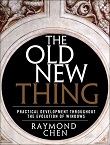- Apr 16, 2017
- 2,087
In the Performance Options control panel, on the tab labeled Visual Effects, there is a radio button called Adjust for best performance. If you select it, then all the visual effects are disabled.
But the name of that radio button has been wrong for a long time. It doesn’t actually adjust your visual effects for best performance. It just adjusts them for crappiest appearance.
Starting in Windows Vista, a lot of visual effects were offloaded to the graphics card. Consequently, the impact on system performance for those visual effects is negligible, and sometimes turning off the effect actually makes your system run slower because you disabled hardware acceleration, forcing operations to be performed in software.
For example, if desktop composition is enabled, then a backup copy of a window’s entire contents is kept in video memory, even if the window is covered by other windows. Without desktop composition, the window manager uses the classic model which follows the principle don’t save anything you can recalculate: The contents of an occluded window are not saved anywhere, and when the window becomes exposed, the window receives a WM_PAINT message to tell it to regenerate its contents.
This means that, for example, when you remove a window from the screen and expose the window underneath, the desktop compositor can show the contents of the underlying window immediately because it saved a copy of the window in video memory and has been keeping it up to date. On the other hand, if you disable desktop composition, you will just stare at a blank window underneath, and then you have to sit and wait for that window to repaint itself.
Congratulations: By disabling desktop composition, you made the act of uncovering a window run slower. (You will see the same effect when switching between maximized windows.)
Okay, so if unchecking these visual effects has negligible and sometimes even a negative effect on performance, why do we still present them in the Visual Effects control panel for people to disable?
Because enthusiasts who think they are so awesomely clever looooove disabling anything that makes the computer look pretty, because they’re convinced that effort making the computer look pretty is clearly done at the expense of performance. They observe that if all the visual effects are disabled, their machine runs fast, but that’s not a controlled experiment because they failed to measure how fast the computer runs when the effects are enabled. (By similar logic, sticking a banana in your ear keeps the alligators away.)
These are the people who think that a bare computer motherboard on a table with components hanging off it runs faster than a computer packed into an attractive case. And even if you demonstrate that it doesn’t actually run faster, they will still keep their computer in its partially-disassembled state because it adds to their street cred.
The Visual Effects settings page turned into a sort of unintended psychology experiment.

"Adjust visual effects for best performance" should really be called "Adjust visual effects for crappiest appearance" - The Old New Thing
In the Performance Options control panel, on the tab labeled Visual Effects, there is a radio button called Adjust for best performance. If you select it, then all the visual effects are disabled. But the name of that radio button has been wrong for a long time.



